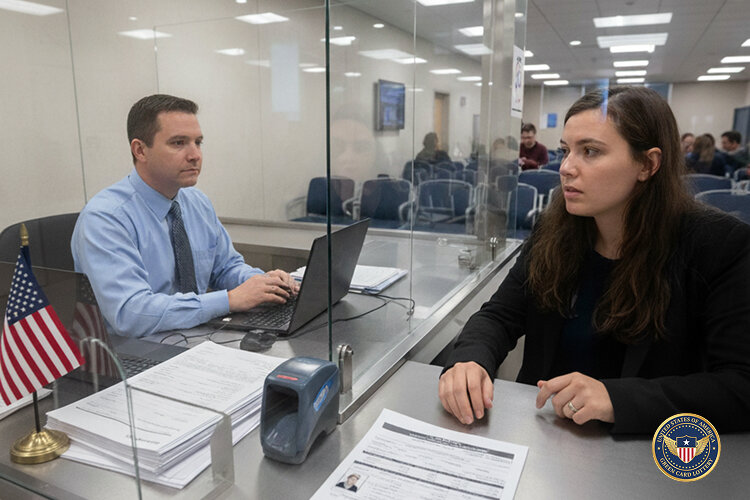
Introduction about B-1 B-2 Visa
The B-1 B-2 Visa is the most common U.S. visitor visa, allowing millions of travelers to enter the United States each year for business (B-1) or tourism (B-2) purposes.
But one of the most frequent questions applicants ask is:
“How long can I stay in the U.S. on a B-1 B-2 Visa?”
This guide explains the authorized stay duration, how to request an extension, what happens if you overstay, and when it might be better to consider long-term U.S. residency options, such as the U.S. Green Card Lottery, through trusted services like the US Green Card Office.
Table of Contents
1. Duration of Stay for B-1 B-2 Visas
When your B-1 B-2 Visa is approved, it does not automatically grant you six months of stay.
Instead, the U.S. Customs and Border Protection (CBP) officer at the airport decides how long you can stay, typically between 1 and 6 months.
You can find your authorized stay period printed on your I-94 Arrival/Departure Record (available online at https://i94.cbp.dhs.gov).
Once that date arrives, you must either leave the U.S. or apply for an extension before your stay expires.

2. Typical Stay Durations
| Visa Type | Purpose of Visit | Usual Stay Duration |
| B-1 (Business) | Meetings, conferences, negotiations | Up to 6 months |
| B-2 (Tourist) | Vacation, visiting family, medical treatment | Up to 6 months |
| Combined B-1/B-2 | Both tourism & business | Usually 6 months |
| Extensions | Must be applied for before expiration | Up to 6 more months |
Most travelers receive 6 6-month stay per entry, but some may get shorter periods depending on their travel history or the officer’s discretion.
3. How to Apply for an Extension
If you need to stay longer, you can file Form I-539 with USCIS before your current authorized stay expires.
You must show:
- A valid reason for extending (e.g., ongoing meetings, health issues, or family events).
- Financial proof that you can support yourself without working.
- Strong ties to your home country (property, job, family) to show you’ll return.
Once you file, you’ll receive a receipt notice, allowing you to stay legally while your application is pending, even if your I-94 expires.

4. What Happens If You Overstay?

Overstaying a B-1 B-2 Visa can lead to serious immigration consequences, such as:
- Visa cancellation and future entry bans.
- Ineligibility for future U.S. visas for 3 or 10 years (depending on overstay length).
- Denial of future Green Card or immigration benefits.
To avoid these issues, regularly monitor your I-94 expiration date. If you plan to live permanently in the U.S., consider legal immigration programs like the Diversity Visa (Green Card) Lottery.
The US Green Card Office offers professional assistance to submit error-free applications year-round, helping you avoid disqualification from simple mistakes.
5. Can You Visit Multiple Times on a B-1 B-2 Visa?
Yes! A B-1 B-2 Visa can be valid for up to 10 years and allows multiple entries.
However, each entry is treated separately, and the CBP officer again determines the duration of each visit.
If you frequently visit and stay long periods, the U.S. may suspect you are living there illegally on a tourist visa. To prevent this, maintain a clear travel record and balance your time abroad.
6. Changing or Adjusting Your Status
If your circumstances change, for example, you’re offered a job, get married to a U.S. citizen, or decide to study, you may be eligible to change your visa status while in the U.S.
However, this is a complex process, and not all B-1/B-2 holders qualify.
For those looking for a more straightforward, legal path to permanent residency, applying for the Green Card Lottery through experts like US Green Card Office is a great alternative. They handle all the details of your application, reducing the risk of disqualification.

7. Common Mistakes to Avoid
- Overstaying even a few days beyond your I-94.
- Engaging in work or study is not allowed on your visa.
- Frequent entries that suggest you’re living in the U.S.
- Failure to apply for an extension on time.
- Misrepresenting your purpose during the visa interview or at entry.
Avoiding these mistakes helps you maintain your U.S. travel privileges and ensures smooth future visits.

8. When to Consider a Different Visa
If you want to:
- Study in the U.S. → apply for an F-1 visa
- Work temporarily → apply for H-1B, L-1, or O-1
- Immigrate permanently → apply for a Green Card via employment, family, or the Diversity Visa Lottery
The US Green Card Office can assist with Diversity Visa Lottery applications, helping thousands of applicants each year successfully enter the program and prepare for life in the United States.
Conclusion
The B-1 B-2 Visa offers flexibility for short-term U.S. visits, but strict compliance with duration limits and visa rules is crucial. Constantly monitor your authorized stay, apply for extensions early, and maintain transparency with U.S. immigration officials.
For those inspired to turn short visits into long-term residency dreams, the US Green Card Office provides trusted, professional assistance with Green Card Lottery applications, helping applicants from eligible countries submit their applications correctly and confidently year-round.


